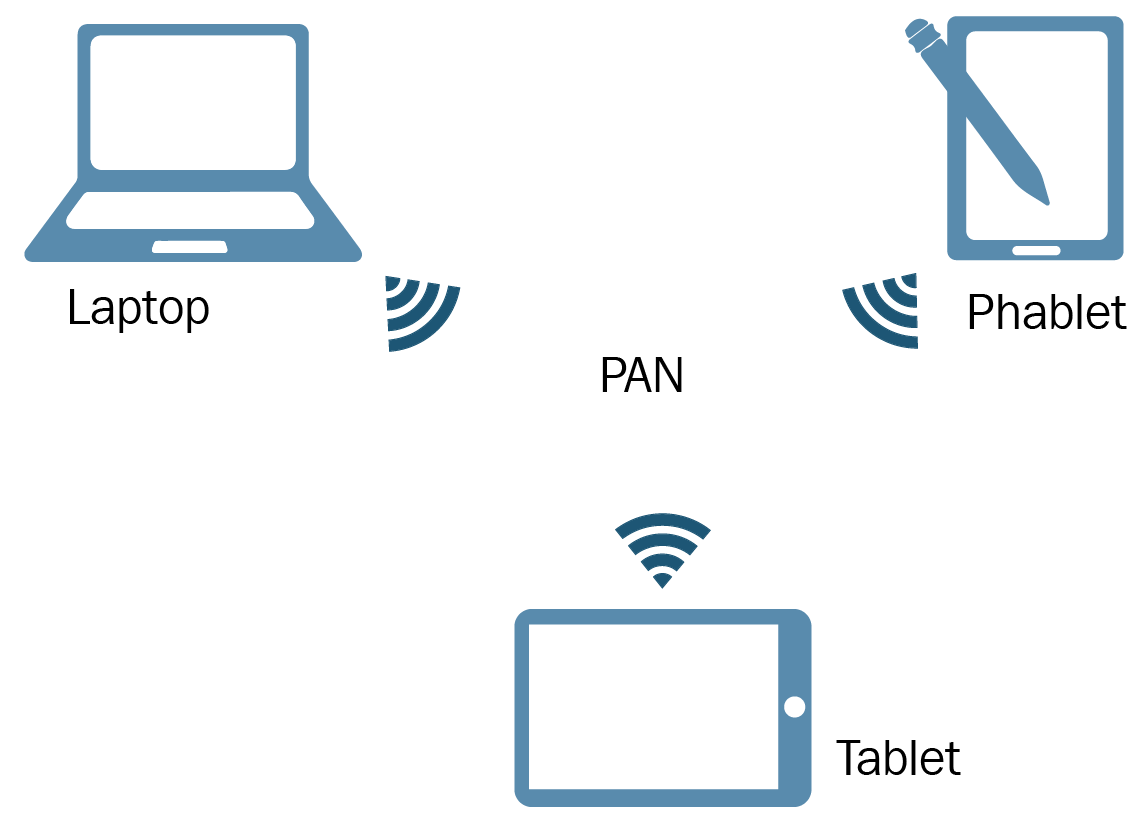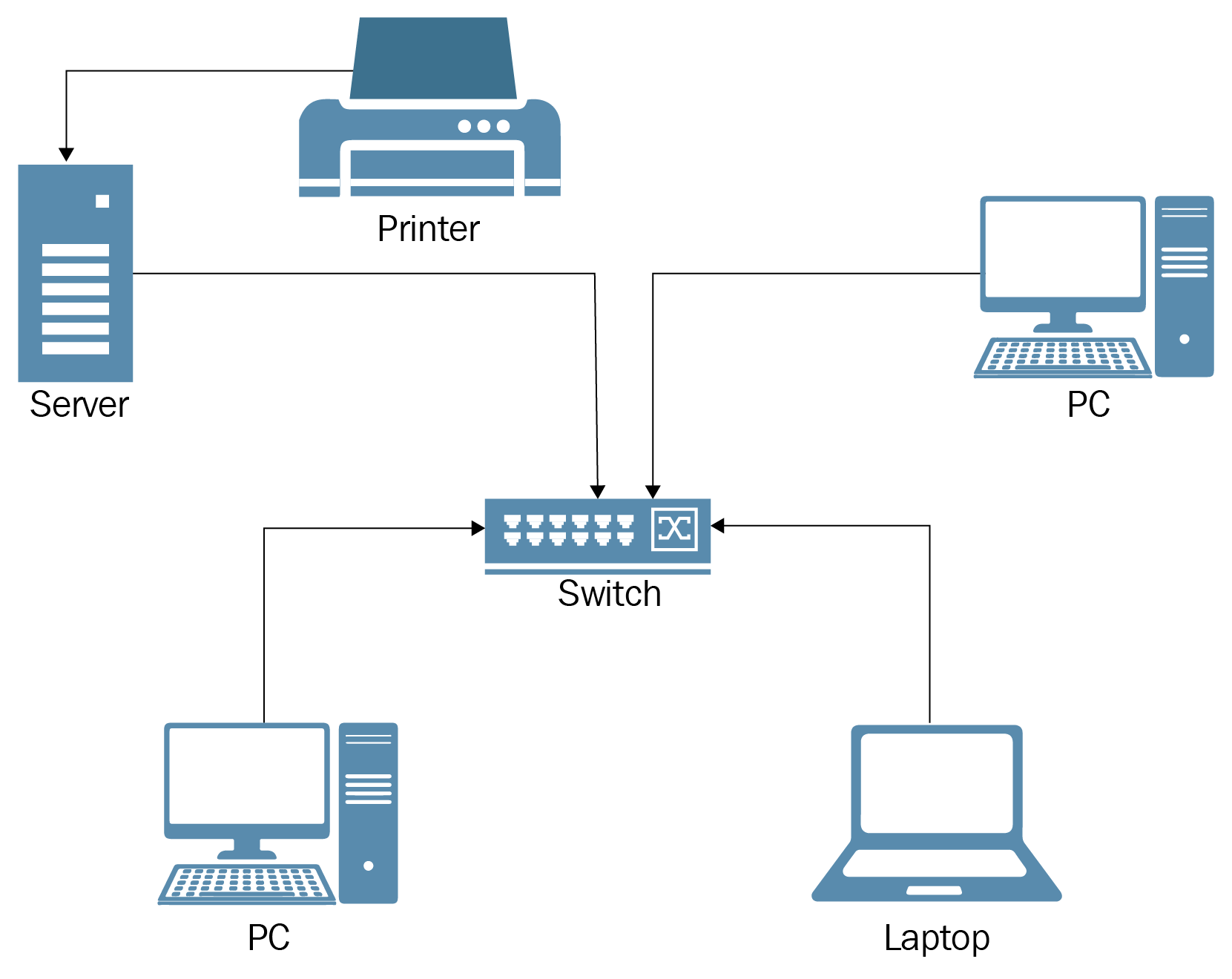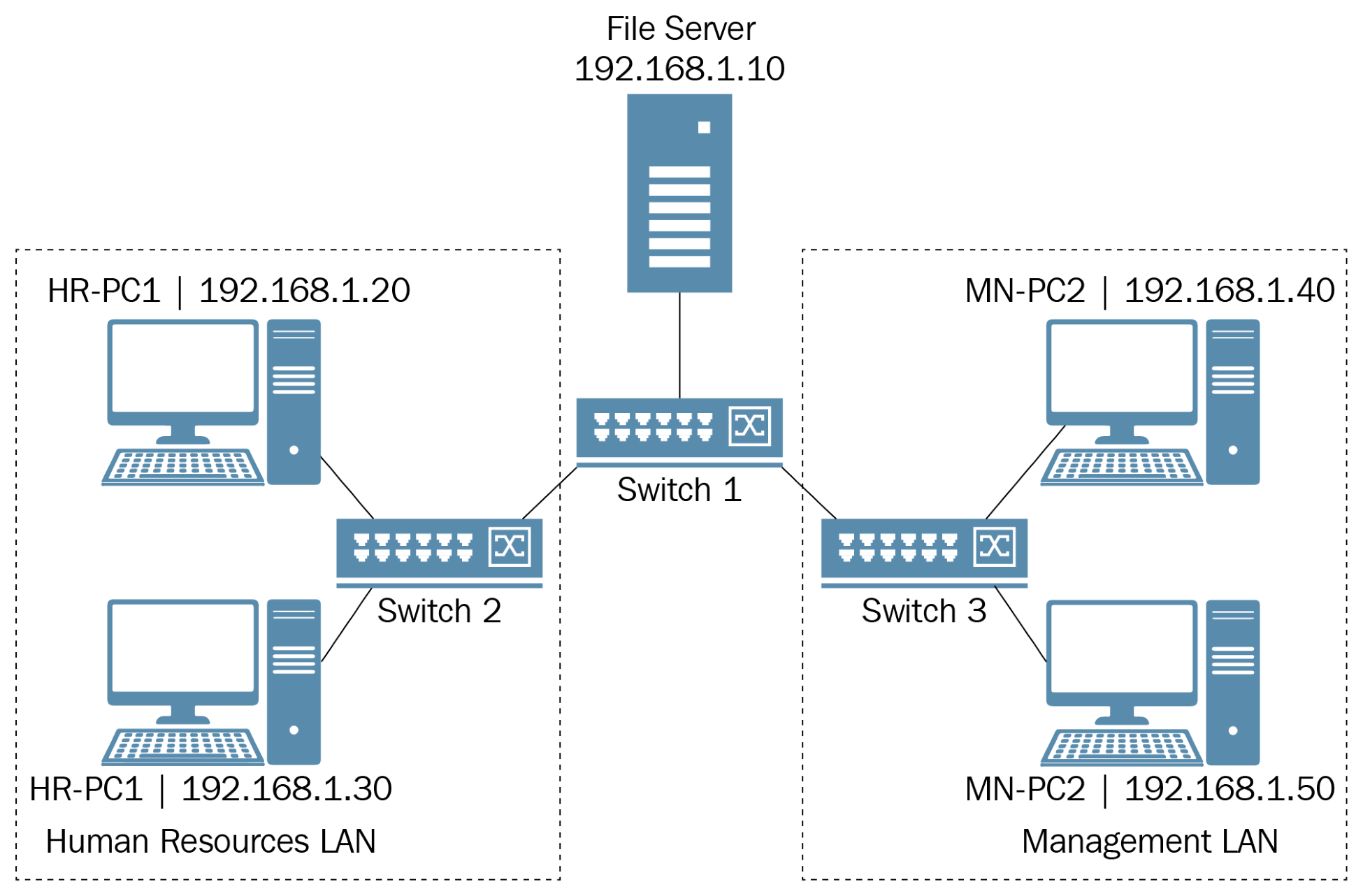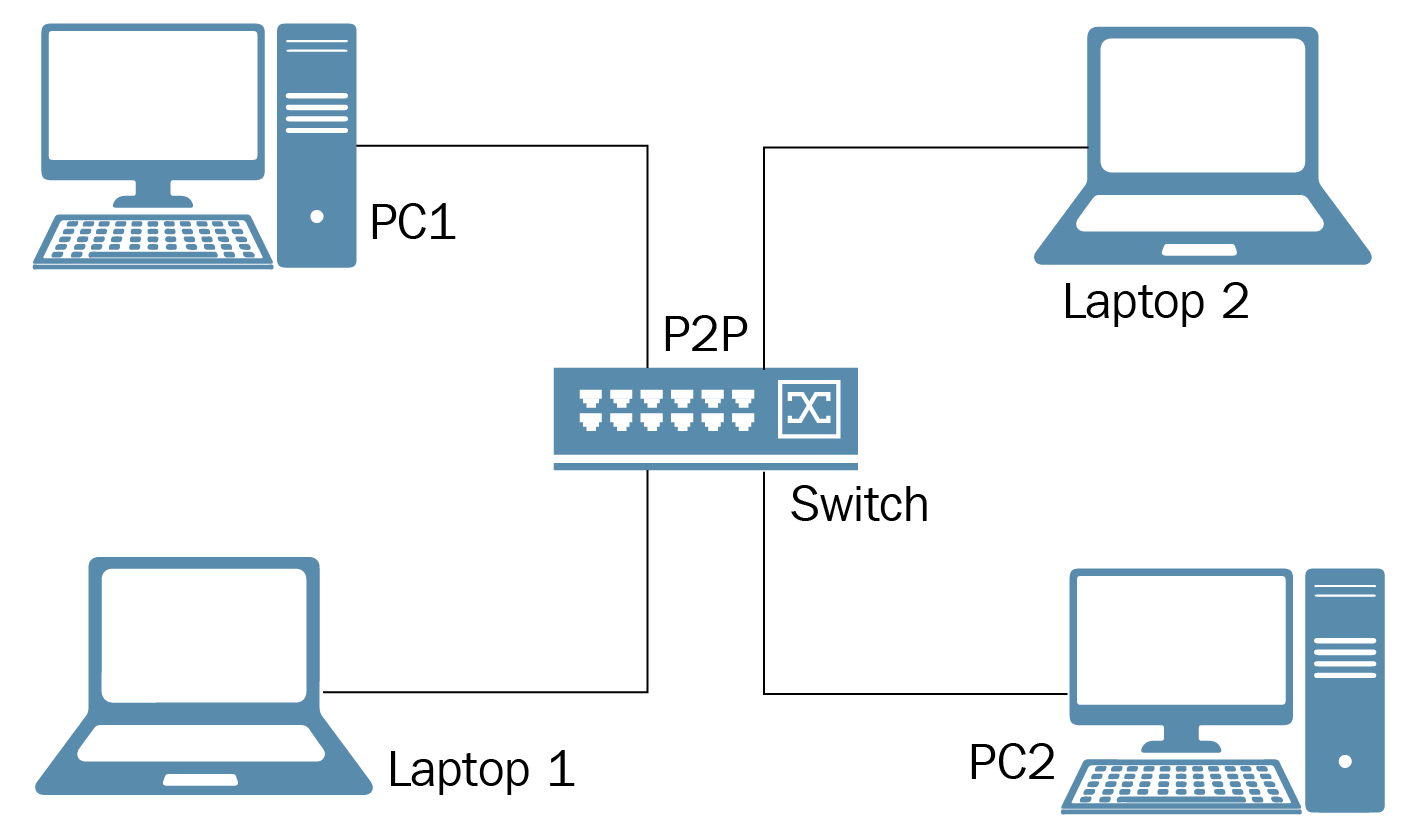It all began many years ago when the need for sharing resources became a necessity. As time went by and demands increased, the development and advancement of computer network technologies also took place. With that, more computers were connected to computer networks and geographical distances were diminished in terms of communication. It created a need for well-defined terms and concepts to describe computer networking. Because of that, different types of computer networks, network topologies, architectures, and components have emerged.
Let's begin by understanding what a computer network is.
From my experience, people often confuse what a computer network is with what a computer network does. While the first explains what constitutes a computer network, the latter shows the benefits of a computer network. In Figure 1.1 we can see that a computer network is a group of computers connected to each other in order to share resources. The resources are usually data, network services, and peripheral devices:

Figure 1.1: A typical computer network
A computer network is divided into different types. Let's take a look at each of them individually.
In general, the categorization of computer networks consists of the area they cover and the purpose they serve. Some of the most popular types of computer networks nowadays are described in the following subsections.
A Personal Area Network (Figure 1.2) is a computer network that is used to connect and transmit data among devices located in a private area that is partially or completely protected from external access. Bluetooth and Wi-Fi are the most common communication technologies used to interconnect devices in a PAN. Often, a PAN is also known as a Home Area Network (HAN):

Figure 1.2: A PAN
Another type of network is local area network (LAN). However its coverage is far greater than a PAN. Let's learn more about it next section.
A LAN (Figure 1.3) is a computer network that connects two or more computers in a local area. Try to understand a local area as one single room, a floor, several floors, a building, or several buildings adjacent to each other at a distance that Ethernet communication technology permits. A LAN usually utilizes a central device that uses twisted pair, coaxial, or fiber optic cables as a networking media to interconnect computers:

Figure 1.3: A LAN
The next type of network that we are going to look at is the Metropolitan Area Network (MAN).Its coverage is even greater than a LAN.
In contrast to a LAN, a MAN (Figure 1.4) represents a group of LANs interconnected within the geographical boundary of a town or city. Nowadays, fiber optics and gigabit layer 3 switches are used to interconnect LANs and route the traffic among them, as seen in the following figure:

Figure 1.4: A Metropolitan Area Network
Finally, we will understand what is a wide area network (WAN) which has the greatest coverage.
Unlike a MAN, a WAN (as shown in Figure 1.5) is a computer network that covers a wide geographic area using dedicated telecommunication lines such as telephone lines, leased lines, or satellites. WANs cover large geographic areas and, as such, they do not have geographic restrictions. The internet is the best example of a WAN:

Figure 1.5: A Wide Area Network
Now that we've understood the different types of computer networks, let's take a look at the underlying components that make up these networks.
Just as PCs have components, computer networks have their own components, too. Usually, while PCs and peripheral devices are known to most people, components such as networking devices, networking media, and network operating systems (NOS) are mostly known by IT professionals.
Let's first understand what clients and servers in a computer network are.
Let's assume that the network resource is the point of reference for both clients and servers. Then, in a computer network, clients usually request access to resources. On the other hand, servers are responsible for providing resources and managing access to those resources. Both clients and servers play an active role in the computer network. In Figure 1.6, a server with a directly connected printer provides print resources to PCs in the role of resource requests:

Figure 1.6: Client and server in a computer network
Interestingly, the origin of the word servers comes from the word serve. If you search for the word serve in the Merriam-Webster dictionary, among the results, you will find one that says: to provide services that benefit or help. From that, we can think of a server in a computer network as the computer that provides services to clients. In conclusion, the server serves the clients.
Although clients and servers are the most important elements of a computer network, it depends upon hosts and nodes. Let's see how it fits into this structure.
Have you ever heard terms such as hosts and nodes and wondered what they are? Although our first impression might drive us toward thinking that they are the same thing, they are not! While all hosts can be nodes, not every node can act as a host. Hence, a host is any device with an IP address assigned to its network interface that requests or provides networking resources on the network. Usually, clients, servers, and routers act as hosts.
An Internet Protocol address, popularly known as an IP address, is a logical element comprised of numbers that is assigned to host's network interface in order to identify it in a computer network.
However, a node is any device that can receive and transmit the networking resources on the network but has no interface with an IP address assigned to it. Nodes have a network interface that is used for their management. In Figure 1.7, the PCs and the file server act as hosts, while switches act as nodes:

Figure 1.7: Hosts and nodes in a computer network
Now that we have learnt what a network is and its components we are well equipped to understand its architecture.
A computer network architecture represents a computer network design that enables network components to communicate with one another. Computer architecture is actually a framework that incorporates many aspects, such as physical and logical topology, network components, communication protocols, and its operational principles and procedures. Among network architectures, the most popular are Peer-to-Peer (P2P) and client/server.
Let us first understand the P2P network architecture.
P2P, often known as a workgroup, is a computer network (see Figure 1.8) in which hosts do not have predefined roles. Instead, they change roles from client to server, and vice versa, based on their actual activities on the network. For example, if PC1 is requesting resources from PC2, then PC1 acts as the client and PC2 acts as the server. If PC2 requests resources from PC1, then PC2 acts as a client and PC1 acts as the server. Usually, PANs represent the best examples of P2P computer networks:

Figure 1.8: A Peer-to-Peer computer network
Peer-to-Peer (P2P) network architecture refers to a network model in which hosts or computers are equal in terms of capabilities and responsibilities. Having said that, depending on the circumstances, each host may be a client or server depending on whether it requests or provides services in that network.
The next type of network architecture is the Client/Server architecture.
A client/server, often known as a domain-based network, is a computer network (see earlier Figure 1.7) in which hosts have a predefined role. In such a network, hosts that request resources act as clients, whereas hosts that provide resources act as servers. In general, the client/server network architecture is a network with dedicated servers. Usually, LANs, MANs, and WANs represent the best examples of client/server computer networks.
At this point we have a greater understanding of how a network operates. However for a computer to communicate in a network it requires an IP address. We will learn more about this in the next section.
For a computer to be able to communicate in a computer network, it must have an IP address. As explained earlier, the IP address identifies the computer on that network. In addition, in complex networks, we encounter the term subnet, which helps to identify the specific network within the overall network. So far, the world of networks recognizes two IP-addressing technologies: IPv4 and IPv6. Nevertheless, even though IPv6-addressing technology is becoming more and more plausible, it still prefers the role of spectator in the great arena of the internet, in which IPv4-addressing technology continues to be the norm.
Let's first take a look at IPv4 network addresses.
An Internet Protocol version 4 (IPv4) addressing technology—is often referred to as just an IP address. The label v4 represents the fourth version of IP addressing as specified in IETF publication RCF 791. It is a logical element in a network that consists of 32 bits organized into 4 octets with 8 bits each, divided by a decimal point for simplicity of interpretation (for example, 192.168.1.1).
Additionally, the IETF's RFC 791 document organizes IP addresses into 8-bit, 16-bit, or 24-bit prefixes, which introduces the classful addressing that enables IP addresses to be organized into classes of A, B, C, D, and E. With classful addressing, the IP address is split into the bits used for the network portion and bits used for the host portion for a given class.
Now let's take a look at the IPv6 addressing technology which was introduced to overcome the IPv4 address exhaustion of IPv4 network addresses.
An Internet Protocol version 6 (IPv6) addressing technology - is another logical element that identifies a device on a computer network. The label v6 represents the sixth version of IP addressing, as specified in IETF publication RFC 2460. Unlike IPv4, IPv6 is a 128-bit address size organized into 8 hextets with 16 bits each, divided by a colon for simplicity of interpretation (for example, 2001:0DB8:85A3:0000:0000:8A2E:0370:7334). The fact that IPv6 uses 128 bits makes it possible to use 2128 IPv6 addresses which when calculated gives an approximate number of 340 undecillion IPv6 addresses . Undoubtedly, that represents an extremely large number of available IPv6 addresses.
Next, let's take a look at IPv4 subnetting which plays an important role in identifying the network addresses
Subnetting represents a logical division of one large network into multiple smaller networks. In subnetting, a subnet mask plays an important role in identifying the network and determining the size of the network. Additionally, subnetting enables you to identify the network address, host addresses, and broadcast address of a given network. By definition, a subnet mask is a 32-bit address used in combination with an IPv4 address to indicate a network and its hosts.
The default subnet masks, otherwise known as classful networks, for each class of IPv4 addresses are shown:
|
IPv4 Class
|
Default subnet mask
|
|
A
|
255.0.0.0
|
|
B
|
255.255.0.0
|
|
C
|
255.255.255.0
|
So far we have understood what a computer network is and the various types, components, and architectures. In the next section, we will introduce to Windows Server and its related concepts.











